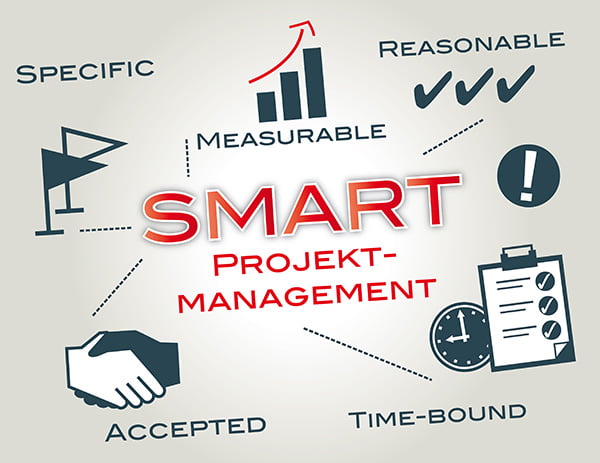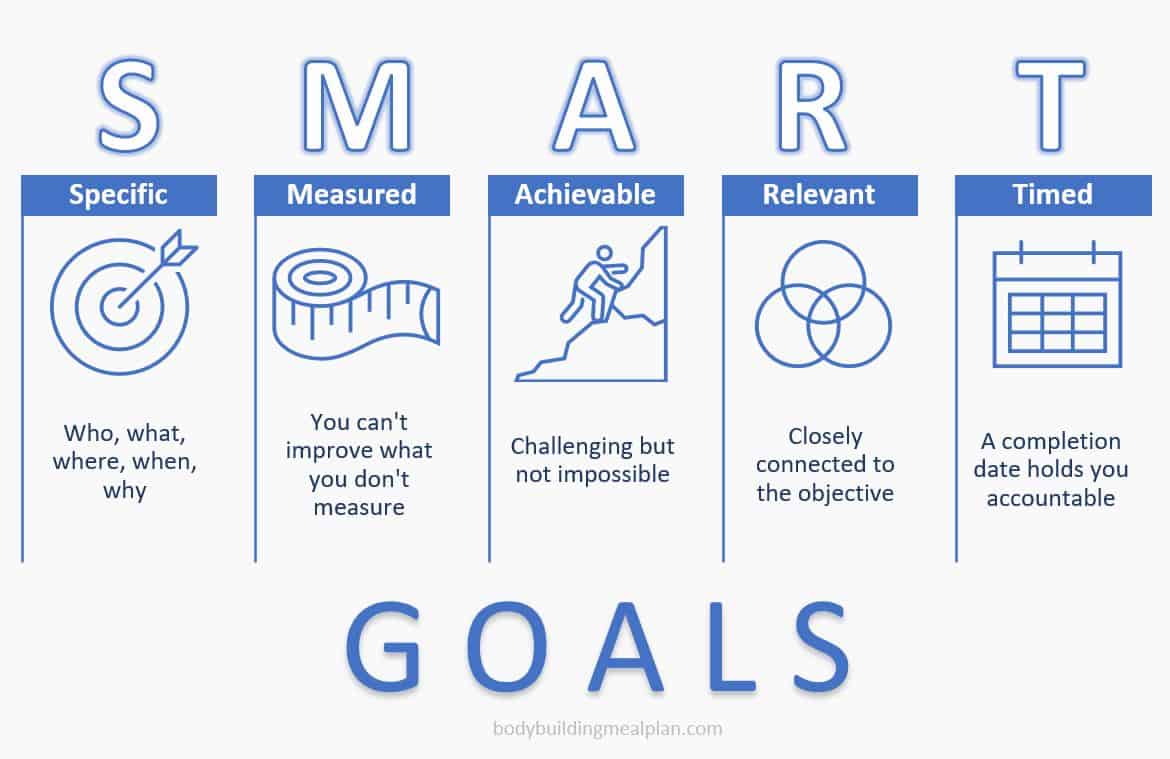SMART in Project Management: Definition, Meaning, & Objectives
Ever wondered why some projects sail smoothly to success while others falter? The secret lies in SMART project management. This approach incorporates the SMART criteria into the project management process, making it more credible and effective. It’s a system combining five key concepts to achieve Specific goals, Measure the process, and ensure Attainability and Relevance to the project’s objectives, all within a Time-bound duration.
If you also want to make your project successful, then this approach can be a way for you. In the upcoming sections, we’ll delve into the five elements of SMART goals for project management. You’ll better understand how to set and track these goals, making your project management tasks a piece of cake. Stay tuned as we unpack the concept and origin of SMART ideology in project management.
What is S.M.A.R.T. in project management?

S.M.A.R.T. in project management refers to an acronym developed to guide goal setting. Each letter stands for the following elements:
- Specific: Clearly defined and detailed goals to eliminate any ambiguity.
- Measurable: Everything that you can track and quantify for accurate assessment.
- Attainable: Goals that are within reach given your project resources.
- Relevant: Goals that align with your project’s objectives and the organization’s strategy.
- Time-bound: Setting realistic deadlines for each goal.
You might wonder how the utilization of SMART objectives in project management elevates your project’s success rate. The beauty lies in its simplicity. By setting SMART goals in project management, you’re able to provide team members with clear and precise objectives. This practical approach enables everyone on your team to understand what’s expected, and significantly enhances project tracking and outcomes.
What are SMART Goals?
When we talk about SMART goals in project management, we are really talking about a planning approach that attempts to break down a larger project goal into smaller, more actionable targets.
1. Specific
First and foremost, SMART goals need to be specific. The action plan for any project should clearly outline your intended outcome. Don’t neglect the details; names, dates, numbers, locations, all add to the specificity of your goals. For example, instead of saying, “I’ll lose weight”, say “I’ll lose 10 lbs”. Ensuring your goals are specific is, without a doubt, one of the most important considerations when formulating SMART objectives in project management.
Looking at the differences offers a clear picture:
| Non-Specific Goal | Specific Goal
|
|---|---|
| To construct a team for project management | To construct a team of 6 members for project management |
| Today I am going to play a game | Today I am going to play Cricket |
| I will have breakfast | I will have Cornflakes and sandwiches for breakfast |
2. Measurable
SMART also implies that project goals should be measurable. Don’t just set goals, set metrics. Ask yourself, “How will I know when I’ve reached my goal?” Quantities, numbers, and metrics such as the number of tasks completed or the number of hours spent on tasks are essential for tracking progress towards your objectives.
Consider this:
| Non-Measurable Goal | Measurable Goal
|
|---|---|
| Make more money this fiscal year | Achieve a 22% increase in revenue compared to last fiscal year |
3. Attainable
Thirdly, your goals must be attainable. It’s great to dream big, but in a project environment, it’s equally important to stay rooted in reality. When setting objectives, consider the resources at your disposal and the external conditions you’ll be operating under.
4. Relevant
The relevance of your goals is another crucial factor. Make sure that what you are planning to achieve aligns with the broader business strategies and objectives. If a goal is relevant, it increases the likelihood that the whole team will actively work towards it.
5. Time-bound
The final element of SMART is being time-bound. It’s not enough to have a specific, measurable, attainable, relevant goal; you also need to have a time frame for reaching it. Deadlines create urgency, keep things moving, and, most importantly, provide a temporal frame to measure your progress against.
Properly understanding what SMART stands for in project management and implementing it effectively in setting up project goals can greatly enhance the chances of your project’s success.
Where Did the Idea of SMART Goals Come From?

The concept of SMART goals isn’t as new. A man named George T. Doran first presented the idea in 1981. His vision was to render goal-setting more practical for organizations. Doran made use of an easy-to-remember acronym—SMART—which stands for Specific, Measurable, Assignable, Realistic, and Time-related. Each word in this mnemonic represents a criterion that each project goal should meet to ensure efficiency and effectiveness.
As you can see, SMART goals aren’t just a trendy approach to project management—they’re grounded in decades of best practices that promote success across diverse projects. As you continue your journey, keep in mind that SMART goals help you stay laser-focused on the vision and mission of your project, ensuring that your steps are always advancing in the right direction, minus any unnecessary detours.
Why are SMART Goals Important?
In the realm of project management, SMART goals stand as an aim that’s Specific, Measurable, Achievable, Relevant, and Time-bound. This approach to setting objectives is undoubtedly effective. But what makes them so vital? Here are some key reasons.
1. Simple to Understand
SMART goals are notably straightforward, which makes them simple for project teams to understand. Such specificity in your objectives eliminates room for error or misinterpretation. For example, consider a goal to improve team communication. That’s pretty broad, right? Now, try a SMART goal: “increase and improve teamwide communication by reducing response time to emails by 25% within the next month”. With this SMART goal, you define the ‘what’ (improvement in communication), ‘how’ (reducing email response times), and ‘when’ (within the next month). Easy to grasp, isn’t it?
Remember, specificity is the ‘S’ in SMART and it helps to keep your targets distinct and precise. Specific goals always include definitive, descriptive language, which ensures everyone on your team knows exactly what they’re aiming for. With each person clear on their function, they’re set to function correctly!
2. Clear Timeframes
‘T’ in SMART stands for Time-bound and it’s another key feature of these goals. Often, you’ll find that goals tend to falter without a clear timeframe. Deadlines set within SMART goals provide a sense of urgency and help maintain focus. Since these goals come equipped with specific deadlines, they ensure that every task is completed in a timely manner, thereby controlling the pacing of the project.
For instance, let’s consider a sales oriented SMART goal: “Get new paid-plan users by converting 25% of free trial users within the next six months”. Here, the six-months deadline gives your sales team a clear timeframe to work with, keeping faltering productivity at bay.
3. Easy to Review
Lastly, one of the gripping advantages of SMART goals in project management is their measurability. As the ‘M’ suggests, these objectives are always quantifiable. Whether you’re tracking the number of tasks yet to be completed, the time taken to conclude one task, or the collective hours your team is working, SMART goals have your back.
With metrics and numbers showcasing your progress, you can effectively keep tab of how much closer you are to achieving your objectives. This not only helps in recognizing developmental areas but also celebrates small wins along the way, boosting morale.
SMART goals inherently foster a dynamic environment of productivity and effectiveness. Therefore, understanding them and implementing them in your project management strategies is an investment that’s bound to yield remarkable results.
Benefits of SMART Goals

When you’re dealing with SMART objectives in project management, a standout quality comes with their benefits. SMART goals bring an incredible amount of value to any project, motivating team members, and improving processes along the course.
1. Increase Value
The first major benefit of utilizing smart goals in project management lies in the immense value they add. Your project goals become incredibly clear, allowing every team member to understand what’s expected of them. Having these specifics helps drive the project effectively to a successful finish line.
Assigning numerical targets to each goal makes them measurable. You’re then able to gauge your performance with accurate metrics, identifying areas where you’re falling short and where you’re excelling. It gives no room for nebulous results, transforming every success or failure into a tangible learning point. This, in turn, boosts overall productivity, leading to increased value for your client and your team.
2. Motivate
Secondly, what is SMART in project management if not a source of fantastic motivation? By setting achievable goals, you’re essentially creating an environment where your team members can thrive. An objective that’s too challenging can cause undue stress, while a goal that’s too easy won’t push individuals to utilize their full potential. With SMART goals, you strike the right balance – goals big enough to inspire, yet realistic enough to be attainable. The promise of a reward upon successful completion of a project, for example, can significantly amplify motivation levels.
3. Improve Processes
Finally, SMART goals in project management also serve to improve your processes remarkably. The aspects of a SMART goal – being specific, measurable, achievable, relevant, and time-bound – each contribute to optimize your processes. By providing explicit instructions, you eliminate inefficiencies. By tracking progress with measurable goals, you’re able to fine-tune your methods along the way. By setting achievable and relevant goals, you ensure your team is equipped with the necessary skills and knowledge and their efforts align with the project’s and the organization’s objectives. By establishing a deadline, you foster a culture of productivity, discouraging procrastination and pushing your team to tackle tasks head-on.
How to Create SMART Goals? (Easy Steps)

Step 1. Identify a Weakness
The first step in creating SMART objectives in project management is identifying a weakness within your team or project. This weakness is often the area that needs improvement. Working on this can lead to better productivity and success rates, thus adding value to the project. As a result, you should focus on identifying these weaknesses and setting goals to overcome them.
Step 2. Consider Improvements
After identifying the weakness, consider possible improvements. What measures can you implement to overcome these challenges? How can these changes contribute to the success of the project? Once you’ve considered these, it’s time to outline SMART goals in project management.
Step 3. Draft Your SMART Goal
Begin forming your SMART goal by considering what is SMART in project management. Remember, SMART stands for Specific, Measurable, Achievable, Relevant, and Time-bound. With these in mind, outline your goal. Ensure it addresses the weakness and improvements previously identified, and that it’s achievable, specifies the expected outcome, relevant to the project, and has a clear deadline.
Consider this example: Improve the communication within the sales team by implementing a new communication tool that will reduce delays and mix-ups, measure success by analyzing the number of incidences every two weeks for the next three months. This statement outlines your goal, provides a measure of success, sets a realistic and achievable outcome, connects directly to the project (i.e., it’s relevant), and provides a time-bound plan.
Step 4. Work with a Capable Team
Remember, what does SMART stand for in project management, apart from the framework, also includes working efficiently with a capable and accountable team. Assign roles and responsibilities to your team members and ensure they understand the goal and how it’s expected to enhance the project. By creating a reliable, accountable team, you’re one step closer to achieving your objectives.
Step 5. Plan and Execute
With your SMART goal clarified and your team briefed, it’s time to act. Begin implementing the changes and improvements identified in your goal. Review the progress regularly, keeping track of milestones and setbacks. This constant feedback will keep your team focused and determined to achieve the goals.
Remember that SMART goals in project management applications aren’t just set and forgotten; they need to be monitored and evaluated regularly. What are SMART goals in project management if not, tools to keep your team focused, on track, and continuously improving; tools to help lead your projects to successful conclusions.
Conclusion
Harnessing the power of SMART in project management isn’t just smart, it’s a game-changer. By pinpointing weak spots, plotting improvements, and crafting goals that are specific, measurable, achievable, relevant, and time-bound, you’re setting the stage for success. A solid team, a well-executed plan, and the right software can take you even further. Remember, feedback is your friend, and accountability is key. So keep your eyes on the prize and your fingers on the pulse of your project. With SMART goals in your toolkit, you’re not just managing projects; you’re leading them to triumph.
Frequently Asked Questions
Q1. What are SMART goals for the project management team?
SMART goals for the project management team are designed to improve communication and collaboration, enhance productivity and performance, and achieve project objectives within given constraints. They also help the team to proactively mitigate risks, gain a strategic understanding of company goals, implement similar initiatives, manage stakeholder expectations, and much more.
Q2. What does SMART stand for in project management?
In project management, SMART stands for Specific, Measurable, Attainable, Relevant, and Time-Bound. This acronym emphasizes the importance of clearly defining project goals, setting measurable targets, ensuring their attainability, making them relevant to the overall project, and tying them to a specific time frame.
Q3. How do you write a SMART goal in project management?
A SMART goal in project management should be Specific, clearly stating what is to be achieved; Measurable, by defining criteria to track progress and confirm achievement of the goal; Achievable, ensuring it’s realistic; Relevant to the project’s overall success; and Time-bound, having a clear deadline for achievement.

Leave a Reply